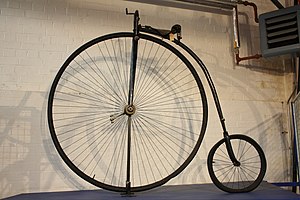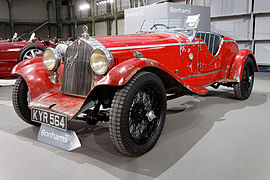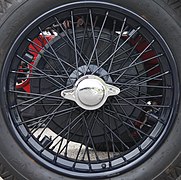와이어 휠
Wire wheel

와이어 휠, 와이어 스포크 휠, 텐션 스포크 휠 또는 "서스펜션" 휠은 와이어 [1][2][3]스포크에 의해 림과 허브가 연결되는 휠입니다.이러한 와이어는 일반적으로 일반적인 와이어 로프보다 강하지만, 장력 유연 와이어와 같은 기계적으로 기능하므로 림은 참된 상태로 유지되며 가해지는 하중을 지탱합니다.서스펜션 휠이라는 용어를 차량 [3]서스펜션과 혼동해서는 안 됩니다.
와이어 휠은 대부분의 자전거에 사용되며 여전히 많은 오토바이에서 사용됩니다.그것들은 1808년 [4]항공 엔지니어 조지 케일리에 의해 발명되었다.케일리는 와이어휠을 처음 제안했지만 특허를 신청하지 않았다.와이어휠에 대한 첫 번째 특허는 1826년 [5]10월 11일 영국 런던의 테오도르 존스에게 발급되었다.1869년 프랑스 파리의 외젠 마이어는 [6]자전거의 와이어 휠 특허를 받은 최초의 사람이다.
접선 스포크가 달린 바퀴가 개발되기 전까지는 자전거 바퀴가 자동차에 충분히 강하지 않았다.그들은 자전거와 모터 세발자전거 세계에서 빠르게 자리를 잡았지만 1907년경까지는 자동차에서 흔하지 않았다.이것은 John Pugh가 디자인한 특허받은 탈부착 및 교환 가능한 바퀴에 의해 고무되었다.이러한 휠은 제동 및 가속 응력에 대한 저항력을 두 줄의 접선 스포크 내부 열에 기인했습니다.레이디얼 스포크의 바깥쪽 열은 코너링 응력에 대한 횡방향 강도를 부여했습니다.이러한 휠은 스티어링 피벗 핀이 타이어의 중심선에 최대한 가깝게 위치하도록 깊게 패여 있었다.두 번째 특징은 스플라인으로 연결된 거짓 허브에 쉽게 탈부착할 수 있다는 것입니다.와이어 휠을 조립하는 프로세스를 휠 빌드라고 합니다.
자동차에 대해서
이 섹션은 확인을 위해 추가 인용문이 필요합니다.(2013년 6월 (이 및 ) |
초기부터 자동차는 철제 바퀴나 무거운 나무 또는 프레스 강철 스포크 포를 사용했다.Rudge-Whitworth 또는 Riley 디자인의 빠른 분리형 허브의 개발은 와이어 휠의 대중화에 크게 기여했고, 우연히 "예비 휠"의 장착으로 이어졌습니다.목제 스포크 포륜이 불충분한 것으로 판명된 후, 많은 미국 제조업체들은 그의 특허를 이용하여 와이어휠을 제조하기 위해 루지-화이트워스의 존 푸에게 로열티를 지불했다.1920년대 후반 포병 바퀴는 인기를 잃었고 조셉 산키의 값싼 프레스 강철 바퀴의 개발은 와이어 바퀴의 프리미엄 가격이 경량화에 의해 정당화되지 않는 곳이라면 와이어 바퀴를 대체했다.
- 와이어 휠에 처음 탑승한 자동차 샘플
롤스로이스 팬텀 III 1937 네이브 플레이트로 유선형의 고품질 중앙 잠금(와이어) 휠
1957 MGA의 와이어 휠
1922년식 Vauxhall 25의 러지 휘트워스 와이어휠
스포츠카
1960년 이전의 스포츠/레이싱 카에는 보통 스플라인 허브가 장착된 러지-화이트워스 중앙 잠금 와이어 휠과 너트의 날개를 특수 합금 망치 또는 "노크 오프 [7]해머"로 쳐서 풀 수 있는 빠른 릴리스의 "노크 오프"(중앙 윙 너트) 잠금[note 1] 캡이 있었다.미국과 서독을 포함한 일부 관할구역은 1960년대 후반 안전상의 이유로 귀걸이 허브캡을 금지했다.이에 대응하여 일부 제조업체(예: Maserati)는 특수 대형 스패너가 [8]필요한 단일 기존의 날개 없는 육각 너트로 캡을 씌워 스플라인 허브에 휠을 고정하는 것을 선호했습니다.
1960년대에는 가벼운 주물 알로이 휠도 처음에는 스플라인 허브와 짝퉁 캡으로 보편화되었고, 지금은 그 휠이 우세합니다.와이어 휠의 새로운 버전은 여전히 제작되지만, 어댑터 없이 장착하기 위해 센터 캡으로 덮인 표준 허브 볼트 패턴을 사용하는 경우가 많습니다.
- 스포츠카 와이어 휠
오토바이로
한때 오토바이는 별도의 부품으로 만든 와이어휠을 사용했지만 지금은 어드벤처, 엔듀로, 흙자전거를 제외하고는 복고풍 외관에 주로 사용되고 있다.
- 와이어 휠이 달린 오토바이
프랑스 산수팝 오토바이의[9] 와이어휠
현대 모터크로스 스타일의 모터사이클 와이어 휠
현대식 엔듀로 스타일의 모터사이클 와이어 휠
현대 크루저 스타일의 모터사이클 와이어 휠
자전거로
처음으로 상업적으로 성공한 유선 바퀴는 자전거였다.그것들은 자전거 개발 초기에 도입되었고, 고체 고무 타이어가 채택된 직후에 도입되었다.이 개발은 무게와 편안함(도로의 [10]진동을 흡수하는 데 도움이 되는 휠의 탄성 증가) 면에서 오래된 나무 바퀴에 비해 크게 개선된 것입니다.
영국에서, 기술자 윌리엄 스탠리는 1849년에 강철로 연결된 스파이더 휠을 개발했는데, 이것은 그의 고용주가 [11][12][13]만들고 있던 세발자전거에 장착된 거추장스러운 나무 스포크 바퀴보다 개선된 것이다.
자전거 제조업체는 인접한 스포크의 교차가 바퀴의 수에 따라 좌우되는 일반적인 교차 스포크 패턴을 사용하여 연간 수백만 개의 바퀴를 제작하고 있습니다.레이싱 팀이나 좋은 자전거 가게의 휠빌더는 2크로스, 1크로스 또는 무크로스(일반적으로 방사형이라고 불린다)와 같은 다른 패턴에 맞춰 휠을 제작합니다.이 패턴들 중 많은 것들이 100년 이상 동안 사용되어 왔다.교차된 패턴은 더 강하고 안정성이 있으며 불규칙한 패턴은 예술 형태이며 구조적인 [14]장점이 거의 없다고 주장합니다.
1980년대에 5, 6개의 단단한 스포크를 가진 캐스트 휠이 올림픽 경기와 프로 레이싱에 등장하기 시작했다.타임 트라이얼과 같은 특수한 용도에는 이점이 있지만 와이어 스포크 휠은 대부분의 용도로 사용됩니다.
스포크 장력 및 타이어 공기압
일반적으로 각 스포크는 비적재 휠에 약 100파운드의 힘을 가합니다.자전거에 라이더가 실리면 허브 아래의 스포크에 장력이 줄어듭니다.휠이 회전할 때마다 스포크 장력이 반복적으로 변화하여 피로 고장으로 인한 스포크 파손의 원인이 될 수 있습니다.피로로 인해 스포크가 기능하지 [15]않게 되는 경우가 많습니다.
공기압이 적절하면 타이어는 경미한 충격과 진동을 흡수하고 120-130psig 범위의 높은 공기압에서 단단하고 유연하지 않은 타이어보다 빠르게 롤링합니다.무거운 승객들은 약간 더 [16]높은 공기압을 필요로 한다.
부하에 대한 반응
자전거에 앉아 있는 라이더에 의한 등 장력이 좋은 와이어 스포크 휠의 반경 하중에 대한 반응은 휠이 지면 접촉 영역 근처에서 약간 평평해지는 것입니다.나머지 휠은 거의 [17][18][19][20]원형으로 유지됩니다.모든 스포크의 장력은 크게 증가하지 않습니다.대신 허브 바로 아래에 있는 스포크만 [14][21][22][23]장력을 감소시킵니다.이 상황을 어떻게 가장 잘 묘사할 것인가에 대한 문제가 [24]논의되고 있다.일부 저자는 허브 아래의 스포크가 허브에 위쪽으로의 힘을 가하지 않고 [19][14]휠의 물리적인 변화 없이 체인으로 대체될 수 있음에도 불구하고 바로 아래의 스포크에 있는 허브가 장력의 감소를 경험한다고 결론짓는다.다른 저자들은 허브가 허브에 상승력을 가하는 위쪽 스포크에 "걸려 있다"고 결론짓고 있으며,[22][25] 허브 아래에 있는 스포크보다 더 높은 장력을 가진다.
얇고 비교적 유연한 스포크로 구성되었지만 와이어 휠은 방사상으로 단단하고 고압 자전거 [26][27][28][29]타이어에 비해 서스펜션 컴플라이언스가 매우 낮습니다.
갤러리
- 와이어 휠
와이어 휠이 달린 초기 할리 데이비슨
포틀랜드 유역 운하 창고에 있는 서스펜션 휠
메모
- ^ 1.3.4 와이어 휠
중앙 잠금 와이어 휠은 전통적으로 오래된 스포츠카나 경주용 자동차와 관련이 있으며, 나이가 든 우리들에게 있어 귀 달린 허브캡에 구리 헤드 해머를 교묘하게 적용함으로써 절약된 몇 초간의 기억으로 여전히 피가 끓는다.우리도 기억해...5페이지, 서스펜션 설계의 콜린 캠벨 새 방향: Making the Fast Car Faster Taylor & Francis, 1981, 미국. ISBN0-8376-0150-9.
레퍼런스
- ^ Forester, John (August 1980). "Held Up By Downward Pull". American Wheelmen. Retrieved 2012-06-26.
how the tension spoked wheel carries its load
- ^ Brown, Sheldon. "Bicycle Tires and Tubes, How a Tire Supports its Load". Retrieved 2012-06-26.
The tension-spoked wheel and the pneumatic tire are two examples of what are called preloaded tensile structures, brilliant, counterintuitive designs working together remarkably to support as much as 100 times their own weight.
- ^ a b C. S. Walker (1920). "Wire Wheels". Society of Automotive Engineers. pp. 425–432. Retrieved 2012-06-26.
As the wire wheel is a "suspension" wheel, the car weight is hung or "cradled" from scores of resilient, flexible spokes.
- ^ Ackroyd, J.A.D. (2011). "Sir George Cayley: The invention of the aeroplane near Scarborough at the time of Trafalgar" (PDF). Journal of Aeronautical History (6): 152.
In the same month, March 1808, the notebook records his invention of the tension wheel in his search for “the lightest possible wheel for aerial navigation cars”. His idea is “.. to do away wooden spokes altogether, and refer the whole firmness of the wheel to the strength of the rim only, by the intervention of tight strong cording.."
- ^ 참조:
- ^ Bulletin des lois de la République francaise(1873) 12번째 시리즈, 제6권, 648쪽, 특허번호 86,705: "Perfectionnements dans les roues de vélocipédes"(자전거 바퀴 개선)는 1869년 8월 4일 발행되었다.
- ^ Wilson McComb. "Principles of the Centre-Lock Wire Wheel". Retrieved 2013-05-18.
Let us take a closer look at this assembly, referring to the central portion of the wheel as the "wheel center", which is fitted to the "hub" and fixed in place with a 'locking cap'.
- ^ Egan, Peter (2016-03-21). "The Smiting of the Knockoffs". Road & Track. Retrieved 2020-03-21.
- ^ "San-Sou-Pap Motorcycles". Cyber Motorcycle. Retrieved 2021-05-08.
- ^ Herlihy, David V (2004). Bicycle: the History. Yale University Press. pp. 141–142. ISBN 0-300-10418-9.
- ^ McConnell, Anita (2004). "Stanley, William Ford Robinson (1829–1909)". Oxford Dictionary of National Biography (online ed.). Oxford University Press. doi:10.1093/ref:odnb/36250. Retrieved 9 September 2009. (구독 또는 영국 공공도서관 회원권 필요)
- ^ Owen, W.B. (1912). Sir Sidney Lee (ed.). Dictionary of National Biography - William Ford Robinson Stanley. Second Supplement. Vol. III (Neil-Young). London: Smith, Elder & Co. pp. 393–394.
- ^ "Good week to go for ride". The Croydon Guardian. 10 June 2006. Retrieved 9 September 2009.
- ^ a b c Brandt, Jobst (1981). The Bicycle Wheel. Avocet. pp. 12–20. ISBN 0-9607236-2-5.
- ^ Max Glaskin (28 April 2015). "The science behind spokes". Cyclist. Retrieved 2021-12-04.
{{cite web}}: CS1 maint :url-status (링크) - ^ Spencer Powlison (13 August 2021). "A Beginner's Guide To Bike Tire Pressure". Retrieved 2021-12-04.
{{cite web}}: CS1 maint :url-status (링크) - ^ Forester, John (August 1980). "Held Up By Downward Pull". American Wheelmen.
- ^ Whitt, Frank R.; David G. Wilson (1982). Bicycling Science (Second ed.). Massachusetts Institute of Technology. pp. 106–138. ISBN 0-262-23111-5.
- ^ a b Ian Smith. "Bicycle Wheel Analysis". Retrieved 2008-12-31.
I conclude that it is perfectly reasonable to say that the hub stands on the lower spokes, and that it does not hang from the upper spokes.
- ^ C.J. Burgoyne and R. Dilmaghanian (March 1993). "Bicycle Wheel as Prestressed Structure" (PDF). Journal of Engineering Mechanics. 119 (3): 439–455. doi:10.1061/(asce)0733-9399(1993)119:3(439). ISSN 0733-9399.
- ^ Wilson, David Gordon; Jim Papadopoulos (2004). Bicycling Science (Third ed.). Massachusetts Institute of Technology. pp. 389–390. ISBN 0-262-73154-1.
- ^ a b Tom Fine (September 1998). "Hubs hang from the rim!". Retrieved 2010-03-16.
I still say, without any doubt, that the hub hangs from the upper spokes.
- ^ Henri P. Gavin (August 1996). "Bicycle Wheel Spoke Patterns and Spoke Fatigue" (PDF). Journal of Engineering Mechanics. 122 (8): 736–742. doi:10.1061/(ASCE)0733-9399(1996)122:8(736).
- ^ Kraig Willett (5 September 2004). "Hang or Stand?". BikeTech Review. Retrieved 2010-03-16.
A little known semantic debate ... has been raging on the usenet newsgroups for quite some time. The point of contention in this debate is whether or not a loaded bicycle wheel "stands" on the bottom spokes or "hangs" from the top ones?
- ^ Samuel K. Clark, V. E. Gough (1981). Mechanics of Pneumatic Tires. U.S. Department of Transportation. p. 241.
The system of load transmission is analogous to that of a cycle wheel where the hub hangs by the steel wire spokes from the top of the rim, which is loaded at the bottom.
- ^ John Swanson (2006). "Performance of the Bicycle Wheel, A Method for Analysis" (PDF). BikePhysics.com. Retrieved 2012-06-25.
Radial Stiffness: There's almost -no- vertical compliance in your wheel and people who insist that they can feel the vertical stiffness or “harshness” of a wheel are mistaken. The radial stiffness of a bicycle wheel is ~ 3-4000 N/mm. This equals a deflection of 0.1 mm under a 40 kg load. Sorry princess, but that gets obscured by the amount of deflection in the tires, fork, saddle, handlebar tape, frame, and even your gloves.
- ^ Henri P. Gavin (1996). "Bicycle Wheel Spoke Patterns and Spoke Fatigue" (PDF). Journal of Engineering Mechanics. Retrieved 2012-06-25.
radial wheel stiffness (N/mm): 2500-5000
- ^ Ian (2002). "Spoke Patterns". astounding.org.uk. Retrieved 2012-06-25.
A radially spoked wheel is about 4.6% stiffer than a tangentially spoked one. Alternatively, if you apply 1000N (about 100kg, 220lb) to each of the wheels, the tangential (four-cross) spoked one deflects 0.0075mm (0.0003 inch) more than the radial spoked. Since the tyre is likely to deflect several millimetres at least (if 3mm, that's 400 times more deflection) I conclude the spoking is unlikely to make a discernible difference to the vertical stiffness of the wheel.
- ^ Jobst Brandt (1981). "Sheldon Brown's Bicycle Glossary: Radial spoking". Sheldon Brown (bicycle mechanic). Retrieved 2012-06-25.
There is no change in radial elasticity between a radial and crossed spoke wheel with the same components, other than the length of the spokes. A 290 mm spoke is 3% stiffer than a 300 mm spoke of the same type. Since spokes stretch elastically about 0.1mm on a hard bump (not ordinary road ripples), the elastic difference between the radial and cross-three wheel is 3% x 0.1mm = 0.003 mm. Copier paper is 0.075 mm thick, and if you can feel that when you ride over it on a glassy smooth concrete surface, please let me know. You have greater sensitivity than the lady in "the princess and the pea" fable.












![Wire wheels on a French San Sou Pap motorcycle[9]](http://upload.wikimedia.org/wikipedia/commons/thumb/8/85/Sans_sou_pap.jpg/120px-Sans_sou_pap.jpg)









